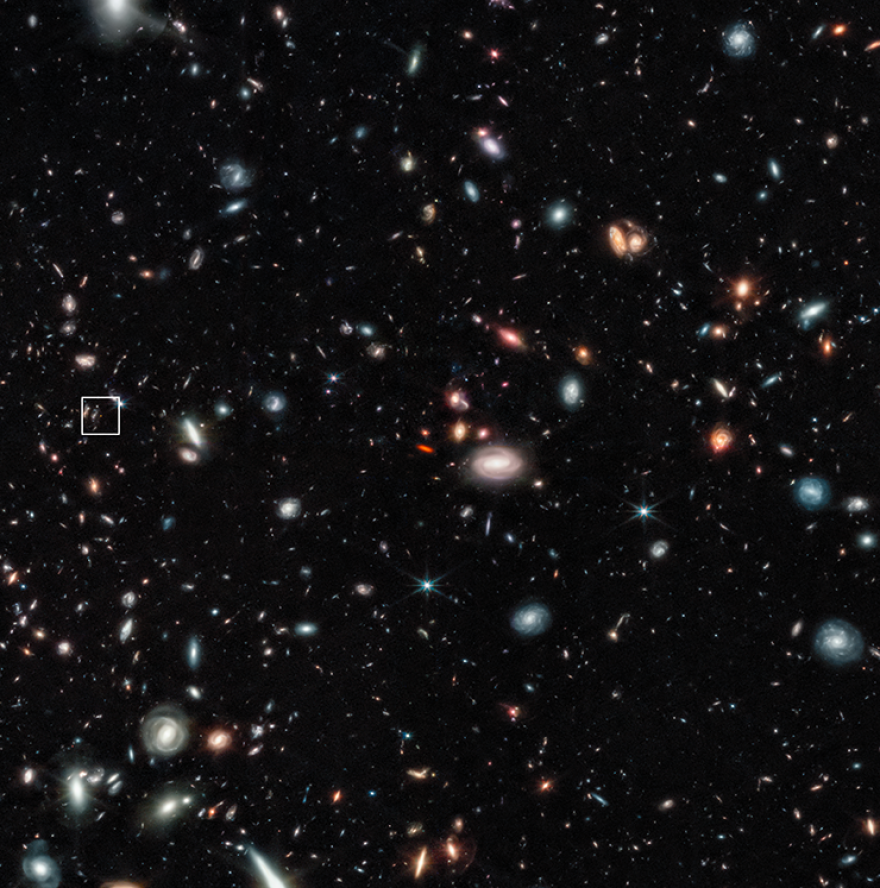This story is free to read because readers choose to support LAist. If you find value in independent local reporting, make a donation to power our newsroom today.
James Webb telescope spots galaxies near the dawn of time, thrilling scientists

New baby pictures of the universe, taken by the James Webb Space Telescope, show that galaxies started forming faster and earlier than expected.
The telescope launched back in December and it now orbits the sun about a million miles away from Earth. Its giant mirror allows it to detect faint light that's been traveling for almost the entire history of the 13.8 billion-year-old universe. That means it can effectively see what galaxies looked like way back in time.
The snapshots captured so far have both thrilled and perplexed scientists, because it turns out that many luminous galaxies existed when the universe was very young.
"Just a few hundred million years after the Big Bang, there are already lots of galaxies," says Tommaso Treu, an astronomer at the University of California at Los Angeles. "JWST has opened up a new frontier, bringing us closer to understanding how it all began."
In research papers published in The Astrophysical Journal Letters, Treu and other astronomers report the discovery of one galaxy that dates back to just 450 million years after the beginning, and another that dates back to 350 million years.
That latter discovery broke a record set by the Hubble Space Telescope in 2016, when it managed to glimpse a galaxy called GN-z11, which existed about 400 million years after the Big Bang.
Astronomer Garth Illingworth of the University of California, Santa Cruz was a member of the team that found GN-z11, and says that seeing it was "a huge surprise." But now, with the help of their new space telescope, scientists know it wasn't just a weird outlier — because they have at least two more examples.

"These galaxies we're talking about are bright, and so they were hiding just under the limits of what Hubble could do," says Jane Rigby, an operations project scientist for the James Webb Space Telescope. "They were right there waiting for us."
Since astronomers started using JWST, some have claimed to have spotted galaxies from even earlier times, like 250 million years after the Big Bang. But those are more tentative observations.
"We feel very confident about these two, but less confident about the others," says Illingworth. "There's certainly a lot of discussion going on."
The two newly-seen galaxies are both much smaller that our home galaxy, the Milky Way, and one appears to be unexpectedly elongated.
Because so many early, bright galaxies have been seen by JWST, astronomers are having to rethink their old ideas about the evolution of the universe.
"It's exciting for us, from a theoretical standpoint, that maybe there are some open questions about how these galaxies could have formed their stars so much earlier that we're able to detect large numbers of them," says Jeyhan Kartaltepe of the Rochester Institute of Technology.
Finding galaxies like these, and building a greater understanding of how the universe evolved to be what it is today, is why astronomers spent decades and $10 billion dollars to design and launch JWST.
"We can see that we're really on track to realizing the dream of understanding galaxies at the earliest times," says Illingworth. "The last few months have been exciting, but a huge amount remains in front of us to learn."
Copyright 2022 NPR. To see more, visit https://www.npr.org. 9(MDA1OTI3MjQ5MDEyODUwMTE2MzM1YzNmZA004))








